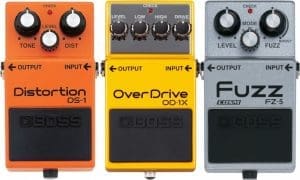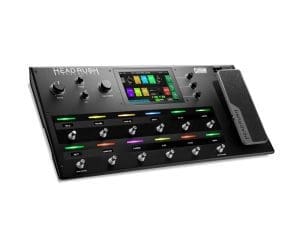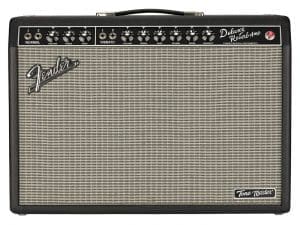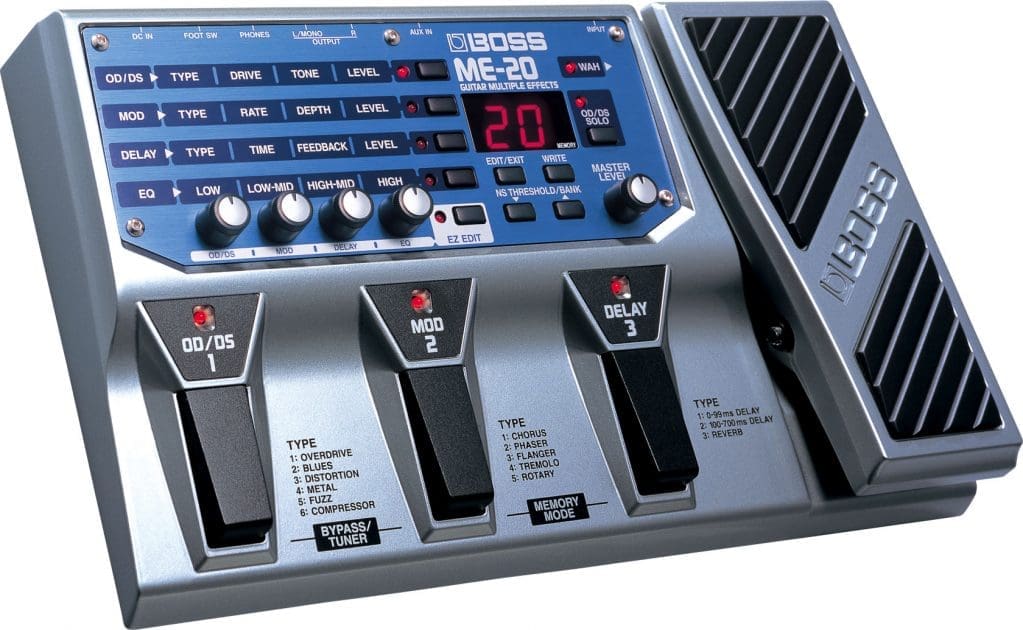Last update 5/2/2024
Effects pedals are cool – we don’t think anyone can debate that statement! Since the introduction of the first effects pedals back in the 1960s, there has been a constant and ever-changing market and demand. Name one type of effect – just one, mind you – and there will be countless versions and models available from many different manufacturers,
Table of contents
While having a good number of guitar effects pedals can open up your sonic options, there are some aspects where having multiple effects pedals are not so cool.
But what are those issues? And how do you get around them?
Before we get into the details here, we’ll jump to the end of the book and offer this up: the answer may be to consider using one of the many multi-effects units out on the market today. But be forewarned – to some players, even mentioning the term ‘multi-effects’ can stir up some strong opinions on why they aren’t as good as ‘the real thing.’
“Every guitar I own gets used and has its purpose.” Mark Knopfler
We beg to differ! Today, we will examine the pros and cons of using a multi-effects unit over a traditional individual pedalboard setup. We encourage you to go into this with an open mind. You never know, but you may find some inspiration to change your entire rig approach.
Cost
There isn’t any accurate comparison between individual effects pedals and multi-effects units. It all comes down to simple math – and once you do that math, you may be surprised.
To build a basic pedalboard, let’s assume that you will want to use each of the following effects:
- Tuner
- Distortion/Overdrive
- Compressor
- Chorus
- Delay
- Flanger
- Wah Pedal
That’s only seven different effects. It may not sound like much, but looking at the actual cost of a setup like this can be an eye-opener.


As we said earlier – it’s simple math:
- Pedalboard: $100
- (7) Individual Effects: $700
- Patch Cords: $50
- Power Solution: $50
That alone adds up to $900 – and it’s for only seven effects. Think about what it would be if you wanted, for example, several types of distortion. Or two or three delays. Heaven forbid you to start adding other effects like reverbs…
By contrast, an excellent array of multi-effects pedals can house many times the same effects and cost less than half the price – and that’s for one of the more respectable, higher-end units. We don’t think there’s much of a con here regarding overall cost – the multi-effects win out in our eyes.


Reliability
Real-life situation – one of our staff writers saw his friend’s band play at a local gig. One of the guitar players got ZERO sound out of his amp as they set up. With only a few minutes before they were to go on, they started troubleshooting frantically to find the problem. And it all came down to – you guessed it – a lousy patch cord. And the guy didn’t carry a spare (shame on him). So he had to do some quick reconfiguring and pick which effect to bypass to get through the gig.
With a multi-effects unit, you don’t have to worry about having numerous connections – everything is internal to the unit itself. Now, that can be a good and a bad thing. It’s good that you don’t have to keep up with all of those patch cords, but it can be harmful because if the unit malfunctions, you might be entirely out of luck.
Effects Quality
It may go without saying, but most multi-effects units are reasonably compact. That means that they have crammed a lot of processing power into a bunch of chips on a circuit board. And that means one thing: most likely, all of the effects are digital.
That may not be a big deal to some players’ ears. For example, digital delay pedals have been around for years. Once you get into other effects, though, the argument can be made that the sound quality may not be up to par with individual effects pedals.
The analog vs. digital debate often arises, especially when distortion and overdrive pedals. These effects are notoriously difficult to capture using a digital model over a true-blue analog circuit. Overall, we would recommend testing out any multi-effects units for the sound quality of the effects you plan to use the most. Some players select analog effects on top of a small multi-effects unit to keep their sound expectations in check.
Amp Modeling
One of the most significant selling points in multi-effects units these days is the ability to have amp modeling included. Amp modeling is genuinely what the name implies: manufacturers create digital models that are meant to represent the output of a real amp, most times mimicking some of the most popular tube amps ever produced.


Technology is constantly evolving, though. While we are getting close to genuinely duplicating the sound of, for example, a cranked Marshall Plexi, to some, it’s ‘just not there yet.’ But it’s close enough for others to do entire gigs or recording projects with no amp.
So, the key takeaway here is that YMMV. Some think that amp modeling is the greatest thing since canned beer, while others may think…not so much.
By contrast, a typical effects pedalboard is simply that – effects only. Yes, you can get individual pedals that do nothing but act as amp simulators. Still, they are usually limited in scope unless you plan to spend $500-plus for one of the several ‘mini all in one’ models that are out on the market today.
The ‘fun’ factor
One of the things that many pedalboard enthusiasts get into is the whole process of creating a pedalboard. That means buying…selling…swapping…and getting into the nuances of making a solution that truly is all their own.
That isn’t much of an option with a multi-effects unit. Yes, you may have 100 different effects to choose from, but the unit you are looking to use may not have the latest and greatest one you want to try out.
For some, it’s not the kill – it’s the thrill of the chase!
Conclusion
So, in the end, are there enough pros to outweigh the cons of using a multi-effects unit over a traditional pedalboard? We would say…it all depends. The individual needs of each player need to be taken into account.
Some may have the budget and the desire to craft a custom effects solution that meets their exacting requirements. Others may be more than satisfied with getting the right quality multi-effects unit, which (usually) has more effects loaded into it than they would ever really use, anyway.
Cost, reliability, and sound quality are among the several things you need to remember when choosing. One significant point to make here as we sign off – whichever way you choose is the right way for you – there IS no right or wrong!
Transparency disclosure: Some of the links in this post are affiliate links, meaning that I may earn a commission if you click on a link and make a purchase. This commission comes at no extra cost to you. We only recommend products and services that I believe are helpful and valuable, and we never let the potential for a commission influence our recommendations.



